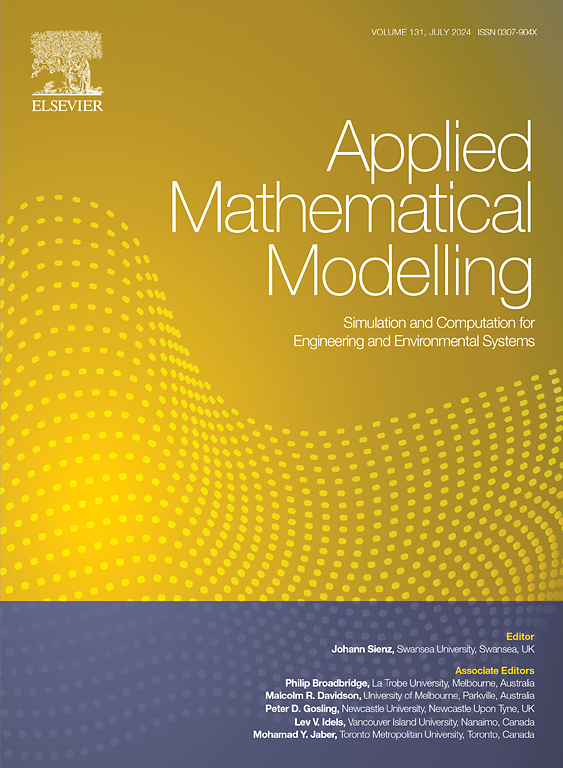考虑混凝土疲劳损伤本构的列车-轨道相互作用长期演化模型及数值实现
IF 4.4
2区 工程技术
Q1 ENGINEERING, MULTIDISCIPLINARY
引用次数: 0
摘要
本文将连续损伤力学与车轨耦合动力学相结合,提出了考虑混凝土材料疲劳损伤的车轨相互作用长期演化分析模型,旨在揭示列车循环运动诱导系统动力性能的演化机理。首先,将空间弹塑性疲劳损伤本构引入车辆-轨道相互作用模型,采用基于算子分割法的数值格式更新轨道结构的应力状态和内部变量;然后,推导出损伤材料的一致切模量,并采用准静态增量法求解考虑材料疲劳损伤的轨道动态响应。此外,构建了基于损伤变量外推和预测的循环跳跃加速度算法,实现了混凝土的高周疲劳分析,并给出了完整的数值实现程序来模拟混凝土的长期行为。将应力、损伤、位移等动态响应与已发表的文献和ABAQUS模型进行综合比较,证明了本工作中各部分的准确性和可靠性。最后,通过数值算例研究了列车作用下轨道损伤值和塑性应变的分布及演化规律,阐述了长期演化模型的适用性。轮轨动力效应是加剧轨道结构疲劳退化的主要内在因素。该工作有利于准确评价轨道结构和列车的动力行为演变,为轨道结构维修提供指导。本文章由计算机程序翻译,如有差异,请以英文原文为准。
Long-term evolution model of the train-track interaction considering the concrete fatigue damage constitutive and numerical implementation
This paper integrates continuous damage mechanics and train-track coupled dynamic, a long-term evolution analysis model for the vehicle-track interaction considering the fatigue damage of the concrete materials is proposed, aiming to reveal the evolution mechanicians of the dynamic performance of system induced by the cyclic moving train. First, a spatial elastoplastic fatigue damage constitutive is introduced into the modelling of the vehicle-track interaction, and a numerical scheme based on the operator split method is employed to update the stress state and internal variables of track structure. Then, a consistent tangent modulus of damaged material is derived, and the quasi-static incremental method is applied to obtain the dynamic response of the track considering the material fatigue damage. In addition, a cyclic jump acceleration algorithm based on the damage variable extrapolation and prediction is constructed to achieve the high-cycle fatigue analysis of concrete, and the complete numerical implementation program is given to simulate the long-term behavior. Comprehensive comparisons of the dynamic response, i.e., stress, damage, and displacement, with published literature and ABAQUS model, demonstrate the accuracy and reliability of each part in this work. Finally, the distribution and evolution law of damage values and plastic strain of track under the train are investigated by the numerical examples, and the applicability of the long-term evolution model is elaborated. The wheel-rail dynamic effect is identified as the main internal factor that exacerbates the fatigue degradation of track structure. This work could be beneficial to accurate evaluation of the dynamic behavior evolution of track structure and train, and provides guidance for the maintenance of track structure.
求助全文
通过发布文献求助,成功后即可免费获取论文全文。
去求助
来源期刊

Applied Mathematical Modelling
数学-工程:综合
CiteScore
9.80
自引率
8.00%
发文量
508
审稿时长
43 days
期刊介绍:
Applied Mathematical Modelling focuses on research related to the mathematical modelling of engineering and environmental processes, manufacturing, and industrial systems. A significant emerging area of research activity involves multiphysics processes, and contributions in this area are particularly encouraged.
This influential publication covers a wide spectrum of subjects including heat transfer, fluid mechanics, CFD, and transport phenomena; solid mechanics and mechanics of metals; electromagnets and MHD; reliability modelling and system optimization; finite volume, finite element, and boundary element procedures; modelling of inventory, industrial, manufacturing and logistics systems for viable decision making; civil engineering systems and structures; mineral and energy resources; relevant software engineering issues associated with CAD and CAE; and materials and metallurgical engineering.
Applied Mathematical Modelling is primarily interested in papers developing increased insights into real-world problems through novel mathematical modelling, novel applications or a combination of these. Papers employing existing numerical techniques must demonstrate sufficient novelty in the solution of practical problems. Papers on fuzzy logic in decision-making or purely financial mathematics are normally not considered. Research on fractional differential equations, bifurcation, and numerical methods needs to include practical examples. Population dynamics must solve realistic scenarios. Papers in the area of logistics and business modelling should demonstrate meaningful managerial insight. Submissions with no real-world application will not be considered.
 求助内容:
求助内容: 应助结果提醒方式:
应助结果提醒方式:


